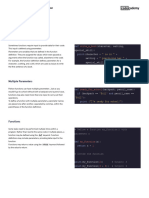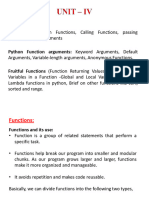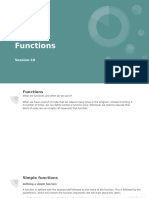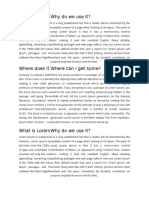Learn Python 3_ Functions Cheatsheet _ Codecademy
Uploaded by
scribd1roanneLearn Python 3_ Functions Cheatsheet _ Codecademy
Uploaded by
scribd1roanneCheatsheets / Learn Python 3
Functions
Lambda Functions
Lambda Functions
A lambda function in Python is a simple, anonymous
function that is defined without a name. Lambda
functions are useful when we want to write a quick
function in one line that can be combined with other
built-in functions such as map() , filter() , and
apply() . This is the syntax to define lambda
functions:
lambda argument(s): expression
Function Parameters
Sometimes functions require input to provide data for def write_a_book(character, setting,
their code. This input is defined using parameters.
Parameters are variables that are defined in the
special_skill):
function definition. They are assigned the values which print(character + " is in " +
were passed as arguments when the function was setting + " practicing her " +
called, elsewhere in the code.
special_skill)
For example, the function definition defines parameters
for a character, a setting, and a skill, which are used as
inputs to write the first sentence of a book.
Multiple Parameters
Python functions can have multiple parameters. Just as def ready_for_school(backpack,
you wouldn’t go to school without both a backpack and
pencil_case):
a pencil case, functions may also need more than one
input to carry out their operations. if (backpack == 'full' and pencil_case
To define a function with multiple parameters, == 'full'):
parameter names are placed one after another,
print ("I'm ready for school!")
separated by commas, within the parentheses of the
function definition.
Functions
Some tasks need to be performed multiple times within # Define a function my_function() with
a program. Rather than rewrite the same code in
parameter x
multiple places, a function may be defined using the
def keyword. Function definitions may include
parameters, providing data input to the function. def my_function(x):
Functions may return a value using the return
return x + 1
keyword followed by the value to return.
# Invoke the function
print(my_function(2)) # Output: 3
print(my_function(3 + 5)) # Output: 9
Function Indentation
Python uses indentation to identify blocks of code. # Indentation is used to identify code
Code within the same block should be indented at the
blocks
same level. A Python function is one type of code
block. All code under a function declaration should be
indented to identify it as part of the function. There can def testfunction(number):
be additional indentation within a function to handle
# This code is part of testfunction
other statements such as for and if so long as
the lines are not indented less than the first line of the print("Inside the testfunction")
function code. sum = 0
for x in range(number):
# More indentation because 'for' has
a code block
# but still part of he function
sum += x
return sum
print("This is not part of testfunction")
Calling Functions
Python uses simple syntax to use, invoke, or call a doHomework()
preexisting function. A function can be called by writing
the name of it, followed by parentheses.
For example, the code provided would call the
doHomework() method.
Function Arguments
Parameters in python are variables — placeholders for def sales(grocery_store, item_on_sale,
the actual values the function needs. When the
cost):
function is called, these values are passed in as
arguments. print(grocery_store + " is selling " +
For example, the arguments passed into the function item_on_sale + " for " + cost)
.sales() are the “The Farmer’s Market”,
“toothpaste”, and “$1” which correspond to the
parameters grocery_store , sales("The Farmer’s Market",
item_on_sale , and cost . "toothpaste", "$1")
Function Keyword Arguments
Python functions can be defined with named def findvolume(length=1, width=1,
arguments which may have default values provided.
depth=1):
When function arguments are passed using their
names, they are referred to as keyword arguments. The print("Length = " + str(length))
use of keyword arguments when calling a function print("Width = " + str(width))
allows the arguments to be passed in any order — not
just the order that they were defined in the function. If
print("Depth = " + str(depth))
the function is invoked without a value for a specific return length * width * depth;
argument, the default value will be used.
findvolume(1, 2, 3)
findvolume(length=5, depth=2, width=4)
findvolume(2, depth=3, width=4)
Returning Multiple Values
Python functions are able to return multiple values def square_point(x, y, z):
using one return statement. All values that should
x_squared = x * x
be returned are listed after the return keyword
and are separated by commas. y_squared = y * y
In the example, the function square_point() z_squared = z * z
returns x_squared , y_squared , and # Return all three values:
z_squared .
return x_squared, y_squared, z_squared
three_squared, four_squared, five_squared
= square_point(3, 4, 5)
The Scope of Variables
In Python, a variable defined inside a function is called a = 5
a local variable. It cannot be used outside of the scope
of the function, and attempting to do so without
defining the variable outside of the function will cause def f1():
an error. a = 2
In the example, the variable a is defined both inside
print(a)
and outside of the function. When the function f1()
is implemented, a is printed as 2 because it is locally
defined to be so. However, when printing a outside of print(a) # Will print 5
the function, a is printed as 5 because it is f1() # Will print 2
implemented outside of the scope of the function.
Returning Value from Function
A return keyword is used to return a value from a def check_leap_year(year):
Python function. The value returned from a function
if year % 4 == 0:
can be assigned to a variable which can then be used in
the program. return str(year) + " is a leap year."
In the example, the function check_leap_year else:
returns a string which indicates if the passed parameter
return str(year) + " is not a leap
is a leap year or not.
year."
year_to_check = 2018
returned_value =
check_leap_year(year_to_check)
print(returned_value) # 2018 is not a
leap year.
Global Variables
A variable that is defined outside of a function is called a = "Hello"
a global variable. It can be accessed inside the body of
a function.
In the example, the variable a is a global variable def prints_a():
because it is defined outside of the function print(a)
prints_a . It is therefore accessible to
prints_a , which will print the value of a .
# will print "Hello"
prints_a()
Parameters as Local Variables
Function parameters behave identically to a function’s def my_function(value):
local variables. They are initialized with the values
print(value)
passed into the function when it was called.
Like local variables, parameters cannot be referenced
from outside the scope of the function. # Pass the value 7 into the function
In the example, the parameter value is defined as
my_function(7)
part of the definition of my_function , and
therefore can only be accessed within
my_function . Attempting to print the contents of # Causes an error as `value` no longer
value from outside the function causes an error. exists
print(value)
Print Share
You might also like
- Learn Python 3 - Functions Cheatsheet - CodecademyNo ratings yetLearn Python 3 - Functions Cheatsheet - Codecademy4 pages
- Learn Python 3 - Functions Cheatsheet - CodecademyNo ratings yetLearn Python 3 - Functions Cheatsheet - Codecademy4 pages
- Learn Python 3_ Functions Cheatsheet _ CodecademyNo ratings yetLearn Python 3_ Functions Cheatsheet _ Codecademy6 pages
- Learn Python 3 - Functions Reference Guide - CodecademyNo ratings yetLearn Python 3 - Functions Reference Guide - Codecademy7 pages
- Learn Python 3 - Functions Cheatsheet - CodecademyNo ratings yetLearn Python 3 - Functions Cheatsheet - Codecademy6 pages
- Learn Python 3 - Functions Reference Guide - CodecademyNo ratings yetLearn Python 3 - Functions Reference Guide - Codecademy7 pages
- Solis_datasheet_S5-GR1P(7-10)K_Global_V4,0_2023_11No ratings yetSolis_datasheet_S5-GR1P(7-10)K_Global_V4,0_2023_112 pages
- Technical Data Sheet For The HSL 3 Heavy Duty Anchor Technical Information ASSET DOC 2331111No ratings yetTechnical Data Sheet For The HSL 3 Heavy Duty Anchor Technical Information ASSET DOC 233111115 pages
- Department of Education: Republic of The Philippines100% (1)Department of Education: Republic of The Philippines2 pages
- English Language:: Hiranandani Foundation School, Thane Portion For Third Comprehensive Assessment-2022-23 STD XINo ratings yetEnglish Language:: Hiranandani Foundation School, Thane Portion For Third Comprehensive Assessment-2022-23 STD XI3 pages
- Laurel vs. Garcia, 187 SCRA 797, G.R. No. 92013, G.R. No. 92047 July 25, 1990No ratings yetLaurel vs. Garcia, 187 SCRA 797, G.R. No. 92013, G.R. No. 92047 July 25, 19902 pages

























































































